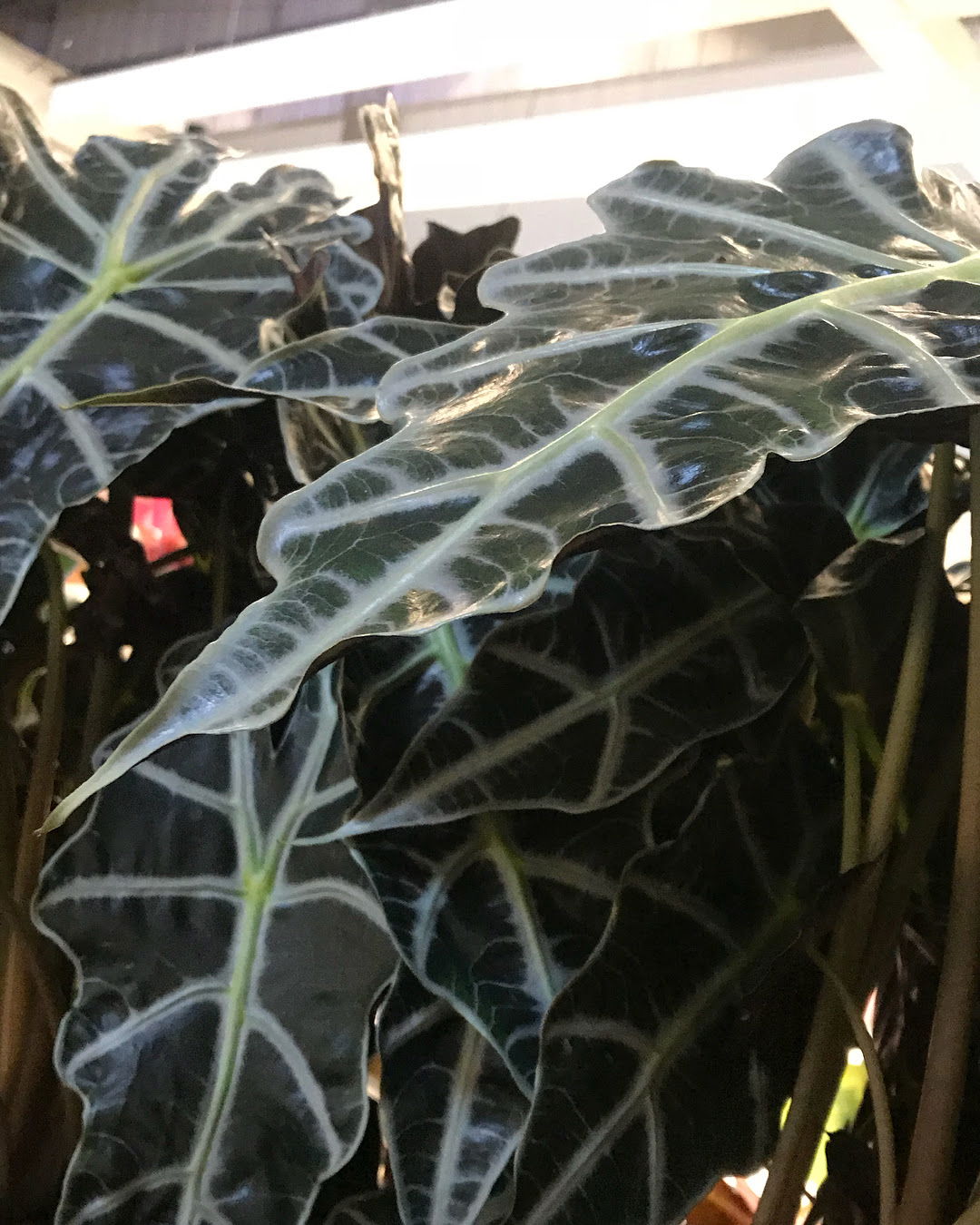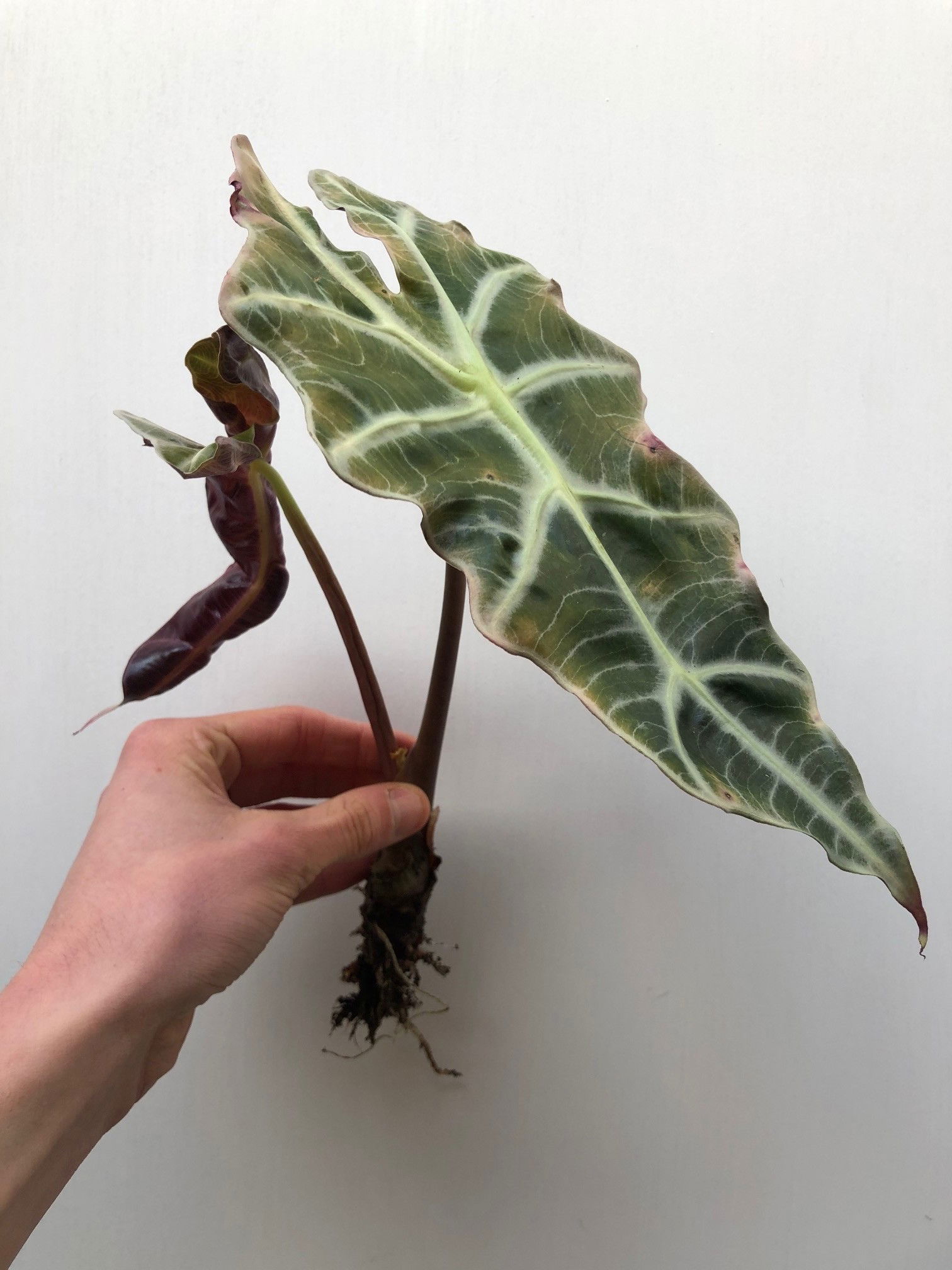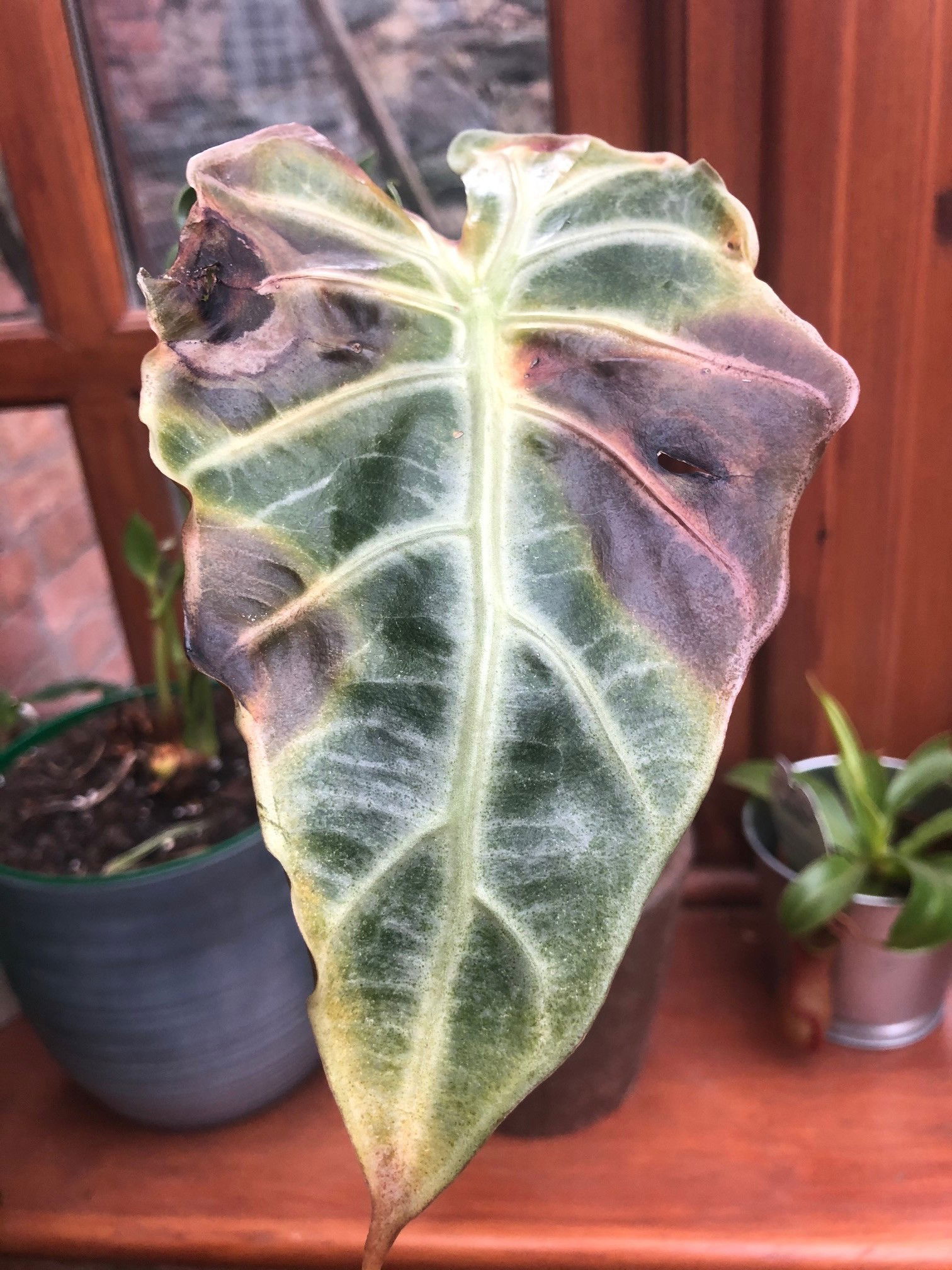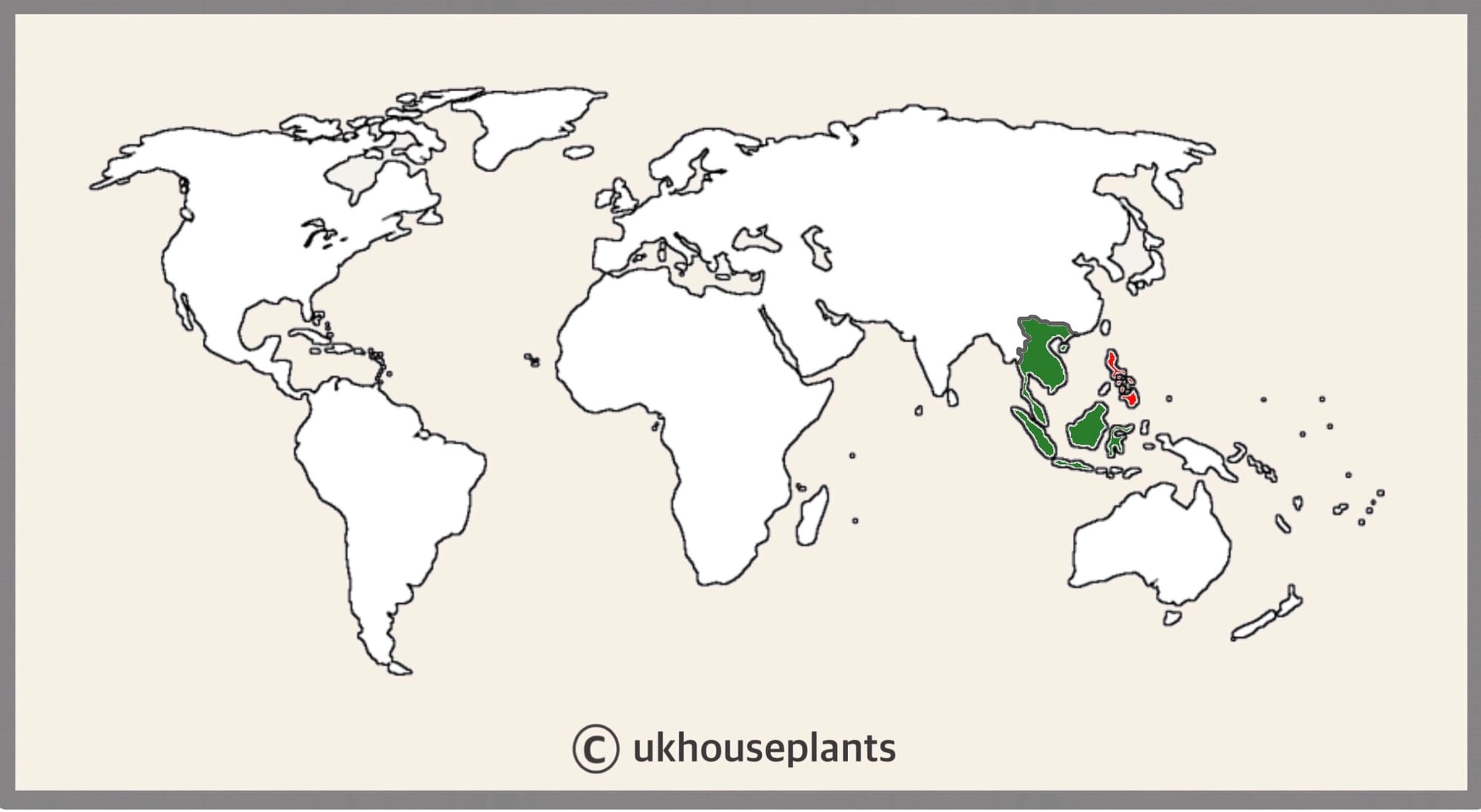
Alocasia × mortfontanensis (commercially sold as Alocasia 'Polly').
Contents
- Top Tips
- Location, Water, Humidity & Fertilisation
- Common Issues
- Origins, Temperature, Propagation, Repotting & Toxicity.
Need the answer to a specific plant query? Book a 1-to-1 video call with THE HOUSEPLANT DOCTOR™, the website's friendly author, to overcome and address your niggling problem! Available on iMessage, WhatsApp, Facebook Messenger & more.
Top Tips & Info
- Care Difficulty - Moderate to Difficult
- This plant likes a bright, indirect area of the home, so either under a growlight or on a north-facing windowsill is best. Although sun should be avoided in the height of summer, an hour or two of autumn/winter sunlight is highly beneficial by relocating it to an east or west-facing windowsill. If in doubt, keep it in a north-facing window all year round though.
- Alocasia 'Amazonica' prefer moist soil. Allow the top third to dry out in between waters, reducing this further in the autumn and winter to avert the risk of over-watering.
- Fertilise using a 'Houseplant' labelled feed every third water in the spring and summer, reducing this to every fourth drink in the autumn and winter.
- Keep an eye out for Spider Mites that'll form webs on the under-leaves of the plant.
- Especially those situated in a dark location, wash or dust the foliage monthly, to increase the light-capturing efficiency and photosynthesis.
- When grown in soil, repot every two years using a 'Houseplant' or 'Alocasia' labelled potting mix and the next sized pot. THE HOUSEPLANT DOCTOR™ recommends using transparent pots with drainage holes so you can monitor its root system for rot.
- If you're ever scared of over-watering your Alocasia, have a go at growing it in Sphagnum Moss with a transparent Orchid pot. The plant will root in the moss, creating a symbiotic relationship between the two. Note: You can either plant bare corms (its 'bulbs') in moss, or by transferring an already-soil grown specimen into moss to grow on. Scroll down to 'Repotting' to learn more on Moss growing.
Location & Light - 🔸🔸
Alocasia are best situated in a bright location that boasts overhead lighting, but if you can't provide this, within two metres of a window will still do the job. Those situated in a shady location must have their leaves rinsed from time to time to improve the light-capturing efficiency. Never allow it to sit in strong sunlight for extended periods, as too much light will result in a pale, washed-out appearance with possible brown patches forming on the leaves.
The amount of light and current season of the year will directly govern the frequencies of waters per month. Specimens placed in darker areas must be kept on the drier side to life, whereas brighter locations will require more soil moisture to lubricate photosynthesis.
Water - 🔸🔸
Allow the top third of the soil dry out in between waters during the active growth period, reducing this further in the autumn and winter. Due to the sensitivity of their root systems, never apply cold water as it may weaken its health and well-being over time. For those that use tap water (instead of rainwater or fresh bottled water), allow it to stand for at least 24hrs to eliminate the high levels of chloride and fluoride found from the tap. Under-watering symptoms include wilting, little to no growth and greying leaves - these issues are commonly down to too much light/heat, or forgetfulness. Alternatively, over-watering symptoms include rapidly yellowing lower leaves, wilting (root rot), brown spots on leaves, and a rotten stem. Specimens that are located in a darker area are more likely to adopt root rot as the soil may not dry out sufficiently in between waters. Remember - under-watering is far better than over-doing it, due to the species' corm that can retain moisture in times of short-lived droughts.
Humidity - 🔸🔸🔸
Average room humidity can be accepted by an Alocasia, but remember to introduce a humidity tray while the heaters are operating to counteract dry air. A quick monthly hose down in the shower will hydrate the leaves, eliminate dust particles and help reduce numbers of pests, most notably Spider Mites.
Fertilisation - 🔸🔸
Feed every four waters during the growing period and every six in the autumn and winter, using a 'Houseplant' labelled fertiliser. Never apply a 'Ready to Use’ product into the soil without a pre-water first, as it may burn the roots and lead to yellowed leaves. Regular supplements are essential for reliable growth during the spring and summer months, as stunted growth could be a cause of irregular feeds.
Common Issues with Alocasia 'Amazonica'
An array of simultaneous cultivation issues will increase the chance of developing yellowed leaf-sections with browned halos. Firstly, the location may be too dark, with its compost staying too saturated in-between waters; if mould is growing across the soil, this is usually a bad sign. Further, you're potentially using too cold water or tap water that hasn't been allowed to sit for 24hrs. The final culprit might be lack of fertilisation, with regular feeds being paramount for long-lasting, healthy leaves. If the specimen hasn't been nourished in over two months, it'll begin to show signs of nutrient deficiencies seen in this article.
If this common problem has occurred with your specimen, remove the affected leaves (not areas) and improve the growing conditions considerably. Fertilise regularly with lukewarm water and be sure to allow the top third to dry out in between hydrations.
Regular waters and fertilisations are essential. Periods of droughts will quickly slip the Alocasia back into its dormancy period, thus causing stunted growth and a bewildered plant owner. If it hasn't repotted in a while, there may be too many roots and not enough soil to retain moisture, thus leaving the compost to dry out quicker. Click on this link to learn more about a transplant.
Leggy or spindly leaves/stems that can snap easily are the result of low light. Increase your plant's light levels by relocating it in a window that offers up to two hours of early morning (before 9am) or evening sunlight (after 7pm), or under a grow light. Don't prune the already-leggy foliage and instead wait for more compact growth that may take up to two months to grow. Feed regularly and maintain reliable soil moisture.
If your Alocasia begins to wilt, it could be the product of one or many issues, ranging from the environment to your care habits. If the specimen is located in too low light, it may lead to plant-confusion when the window is several metres away. As mentioned in 'Location & Light', most Alocasia will require overhead lighting to complement its growth habit, with anything else causing either wilting or slanted growth. Secondly, irregular watering habits could cause root dehydration, which will eventually lead to wilting. Prolonged droughts will result in a lack of hydration in the upper part of the plant, with root rot doing the same - albeit it with overly soggy compost. Finally, environment shock could be the final culprit of your wilting Alocasia. If the specimen has recently been purchased or relocated, the chances are that the specimen hasn't acclimated itself to the new environment. Be sure to provide a bright, indirect setting with the best possible angle to the light source (overhead or nearby a window). Maintain relatively moist soil, allowing the top third to dry between waters and fertilise every two to four weeks, depending on the current season. If you still have questions about your poorly Alocasia, be sure to book a 1-to-1 Call with Joe Bagley to discuss this further!
Foliage-borne Pests could arise at any time, with infestations starting from the original nursery or via contamination in your home. Spider Mites and Mealybugs to tend to be the usual inhabitants, with the first being minute and almost transparent, roaming the leaves in search of chlorophyll and a site to hide its eggs. The latter, however, will stand out much more, with white cottony webs developing across the foliage and stems. Thoroughly check the plant's cubbyholes before giving it the all-clear, or click on the appropriate links to learn more about eradicating these issues!
 Alocasia can be riddled with pests due to its thin, broad leaves. In the image above, there's a third point of interest to look at - mineral/calcium deposits. This is a natural part of an Alocasia leaf's lifecycle, so don't worry about removing them!
Alocasia can be riddled with pests due to its thin, broad leaves. In the image above, there's a third point of interest to look at - mineral/calcium deposits. This is a natural part of an Alocasia leaf's lifecycle, so don't worry about removing them!
Small flies hovering around your plant or soil is entirely natural and may just indicate you're watering a little too often. Fungus Gnats are a common 'pest' with Alocasia due to its dependency to reliable soil moisture, but won't pose any risk to the plant's health. Simply replace the top quarter of the plant's potting mix for a fresh batch of 'Houseplant' labelled compost, typical found at most garden centres.
The rapid yellowing of older leaves and a wobbly plant are a clear sign of over-watering, usually caused by too little light. Although Alocasia can do well in darker locations, the frequency of irrigations must be reduced to counteract the chance of root rot. People don't realise that a plant's root system needs access to oxygen too; when soil is watered, the air will travel upwards and out of the potting mix. A lack of accessible oxygen for the roots will cause them to subsequently breakdown over the oncoming days. Click on this link to learn more about root rot and how to address it, and always feel the pot's weight for confirmation (heaviness = good soil moisture, & vice versa).
 Basal Rot which is caused by too moist soil. As mentioned above, this could spell the end of your specimen if you have this issue.
Basal Rot which is caused by too moist soil. As mentioned above, this could spell the end of your specimen if you have this issue.
Too low humidity can cause browning tips with yellow halos on juvenile leaves. Although this won't kill your specimen, you may want to increase the local moisture to prevent the new growth from adopting these symptoms. Mist or rinse the foliage from time to time and create a humidity tray while the heaters are active to create a stable environment. Browning leaf tips are an inevitable part of a leaf's maturity though, so never be too disheartened if your specimen is showing signs of this!
Clean the leaves regularly. Although this isn't too much of an issue, a build-up of dust particles can clog up the plant's pores, causing lowered light capturing-efficiency. Rinse the topsides of the leaves down once a month to keep levels down and improve growing conditions.
Mould or mushrooms developing on the soil means two things - too little light and over-watering. Despite the harmlessness, it'll prove unsightly to most gardeners and is therefore removed once known. To remove, replace the top two inches of the soil for a fresh batch of 'Houseplant' compost. Either increase the amount of light received (no direct sunlight for the first few weeks to prevent environmental shock) or decrease the frequency of waters slightly. If the mould is accompanied by yellowing lower leaves, you may also have a case of root rot.
There are several species of Leaf-Spot Disease, (Graphiola, Botrytis, Anthracnose & Cercospora) and all of them operate in the same way. Fungi spores will land on the leaf's surface and will slowly develop along with the plant. Unfortunately, as there aren't any products that'll address the issue head-on, you can only remove the affected areas and regularly wash the leaves to limit the spread. In some cases, however, the small yellow spots are caused by inconsistent soil moisture and are not the direct product of a disease. Think about your own cultivation habits and make a decision on what to do.
 This is caused by fertiliser root-burn.
This is caused by fertiliser root-burn.
Other yellowing leaves - it isn't easy to accurately pinpoint why this is happening as it could be due to many different reasons. If the lower leaves are yellowing in quick concession, it could be over-watering. Do not allow the soil to become soggy or waterlogged; failure to do so will cause root rot and possible death. For severe cases, take the plant out of rot pot to examine for root rot - a transplant may have to be performed. The second reason why its leaves are yellowing could be due to either too much sunlight or not enough water. As mentioned above, under-watering can cause an Alocasia 'Amazonica' to slip into its dormancy period. Still, persistent droughts with direct sunlight will cause further damage in the likes of yellowing leaves, stunted growth and wilting.
Origins
There have been many arguments over the similarities between the 'Poly' and 'Amazonica' variants. The only visual difference between the two us that the latter is slightly bigger. Some lean towards the idea that they are the same plant and others with the view that they're different due to the chromosomes. If 'Alocasia polly' is searched on the web, you'll be surprised to find that the original name for this hybrid was the A. poly with only one 'L'. This refers to their polypoid nature, although this was later proved wrong, thus strengthening the idea that the A. amazonica and A. poly could indeed be the same plants.
The arguments over the taxonomy of the two don't end there; the A. amazonica isn't actually from the topics of Brazil; neither is it the actual name of the plant. The term 'Amazonica' can be traced back to the 1950s in Miami when a man named Salvador Mauro created the hybrid in his garden centre named 'Amazon Nurseries'. There have been many arguments over the correct name of the species in question due to the many hybridised versions that have been created; it was only the potentially incorrect 'Amazonica' that remains today. Although the adopted name is traced back to the 50s, it was in fact, the Chantrier brothers who crossed an A. longiloba (previously called A. lowii) and an A. sanderiana to create the hybrid that we know and love today. The name? Alocasia × mortfontanensis, named after the French village, Mortefontaine where the brothers were based.
Unfortunately, it doesn't entirely end there, either! Some botanists still argue that the two are different species, as the latter sports slightly bigger leaves. As well as this, the original name of the A. sanderiana could be called an A. watsoniana, a name that is now considered a synonym and not an individual hybrid. Because of all this intertwined commotion of different names and scientific taxonomy, it's become a tricky situation to resolve fully. Who knows what's actually happened over the 130 years, but one thing for sure, you wouldn't imagine horticulture being this controversial!
 As this plant is a hybrid, and therefore doesn't naturally occur in the wild, the distribution of its parent plants (the Alocasia longiloba in Green & A. sanderiana in Red) has been highlighted.
As this plant is a hybrid, and therefore doesn't naturally occur in the wild, the distribution of its parent plants (the Alocasia longiloba in Green & A. sanderiana in Red) has been highlighted.
Temperature
10° - 30°C (50° - 86°F)
H1b (Hardiness Zone 12) - can be grown outdoors during the summer in a sheltered location with temperatures above 12℃ (54℉), but is fine to remain indoors, too. If you decide to bring this plant outdoors, don't allow it to endure any direct sunlight as it may result in sun-scorch and dehydration. Regularly keep an eye out for pests, especially when re-introducing it back indoors.
Spread
Over 0.7m in height and 0.5m in width once the specimen reaches maturity. The ultimate height will take between 5 - 10 years to achieve, with several new leaves grown per year.
Pruning & Maintenance
Remove yellow or dying leaves, and plant debris to encourage better-growing conditions. While pruning, always use clean utensils or shears to reduce the chance of bacterial and fungal diseases. Never cut through yellowed tissue as this may cause further damage in the likes of diseases or bacterial infections. Remember to make clean incisions as too-damaged wounds may shock the plant, causing weakened growth and a decline in health.
Propagation
Via Seed or Corm Propagation
Corms (Easy to Moderate) - Most Alocasia are have corms, which are small globular-shaped bulbs that'll grow along the root system. A mature Alocasia can produce over twenty corms in its lifetime and can be harvested when you next repot it. Here's how to do it;
- The best time to repot is during the spring or early summer. Make sure that a few hours before repotting, you water the plant's soil to reduce the risk of 'transplant shock' when the roots are disturbed in dry soil.
- Take the mother plant out of its pot and gently work your fingers through the rootball (& soil) until you feel the small ball-shaped 1-2cm corms. Have a look at the image below for what they look like!
- With a clean pair of scissors or a knife, cut off the corm via the 'rhizome' that attaches it to the mother's root system. Make sure around 0.5cm+ of the 'rhizome' is still attached to the corm, so don't prune too close to the bulb itself. Have a look at the image below.
- Once separated, place the corm upright (see image below) and wholly in either soil or Sphagnum Moss. THE HOUSEPLANT DOCTOR™ recommends the moss as you can keep an eye out for root development or sudden issues of rot.
- With the mother plant, repot her back into the next sized pot with a fresh batch of either 'Houseplant' or 'Alocasia' labelled potting mix. If you're growing the mother Alocasia in hydroponics, repot this back into the same pot.
 Extra Tip: A healthy corm should be solid when pinched. Discard any bulbs that are softened or rotten as the bacteria will kill the whole corm.
Extra Tip: A healthy corm should be solid when pinched. Discard any bulbs that are softened or rotten as the bacteria will kill the whole corm.
 Here's a corm that THE HOUSEPLANT DOCTOR™ has grown hydroponically and is now ready to be planted in either soil or moss. (He recommends Sphagnum Moss as a good growing medium).
Here's a corm that THE HOUSEPLANT DOCTOR™ has grown hydroponically and is now ready to be planted in either soil or moss. (He recommends Sphagnum Moss as a good growing medium).
Flowers
As Alocasia 'Amazonica' is part of the Araceæ family, its inflorescences aren't showy. Much like a Peace Lily's flower, its flowers consist of a white or green spathe (the spoon-like shell) with the spadix being the site of pollination. Blooms can last up to three days and are usually visible during late spring or early summer around 30cm+ from the soil line.
In some cases, a show of flowers may indicate the plant is stressed; common causes of this are irregular waters, root rot and environmental shock.
Repotting
Repot every two years in the spring, using a 'Houseplant' or 'Alocasia' labelled potting mix and the next sized pot with adequate drainage. Alocasia 'Amazonica' are far better being potbound for several years due to the heightened risk of root rot and repotting-issues (like transplant shock, which will result in yellowed leaves and wilting), so only repot if you feel it's wholly necessary.
Hydrate the plant 24hrs before tinkering with the roots to prevent the risk of transplant shock. For those situated in a darker location, introduce an extra amount of perlite and grit into the new soil to downplay over-watering risks. Click on this link for a detailed step-by-step guide on transplantation, or via this link to learn about repotting with root rot.
Book a 1-to-1 video call with THE HOUSEPLANT DOCTOR™ if you'd like a personal guide to repotting your houseplant. This will include recommending the right branded-compost and pot size, followed by a live video call whilst you transplant the specimen for step-by-step guidance and answer any further questions!
Growing Alocasia 'Amazonica' in Sphagnum Moss
If your Alocasia keeps losing all of its leaves after they turn yellow, why not have a go at planting it in moss? THE HOUSEPLANT DOCTOR™ recommends this method for when the plant is looking worse-for-wear, or when planting up loose corms (bulbs). For this method, take the plant out of its pot and loosen up the soil in its rootball. Rinse the roots under the tap of warm water to remove any excess soil before planting it up in moss. Use a transparent Orchid pot and place around an inch of moss in the empty pot, before resting the plant's rootball on top. Fill the remaining gaps with more moss until it submerges the whole root system.
Aftercare for Moss-Grown Alocasia: Once the repotting is complete, ensure the moss remains moist at all times. You can use most fertilisers to keep the plant fed (& moss) and wait for new growth. Warm temperatures of around 20℃ (68℉) is good, but remember that the hotter the room, the quicker the moss may dry. You shouldn't need to repot the moss, even if some of the Alocasia's roots have rotted or the foliage has fully died over. Keep it planted up and new growth will emerge via the roots and stems!
Pests & Diseases
Keep an eye out for mealybugs, spider mites, thrips & fungus gnats that'll locate themselves in the cubbyholes and undersides of the leaves. Common diseases associated with Alocasia 'Amazonica' are root rot, leaf-spot disease, botrytis, rust, powdery mildew & southern blight - click here to learn more about these issues.
Toxicity
This plant is classified as poisonous due to varying concentrations of calcium oxalate crystals found around the plant's body. If parts of the plants are eaten, vomiting, nausea and a loss of appetite could occur. Consumption of large quantities must be dealt with quickly; acquire medical assistance for further information.
Retail Locations
IKEA, Blue Diamond & Online Stores.
Book a 1-to-1 Call with THE HOUSEPLANT DOCTOR™
If you need further advice with your houseplants, book an advice call with ukhouseplants' friendly and expert writer today! This can be done via a video or audio call on most apps, including Facebook, FaceTime & Skype. A ten-minute call costs £5.99 (US$7), or £15.99 for thirty minutes. You can ask multiple questions, including queries on plants, pests, terrariums, repotting advice and anything in between. Please consider supporting this service to keep ukhouseplants thriving!